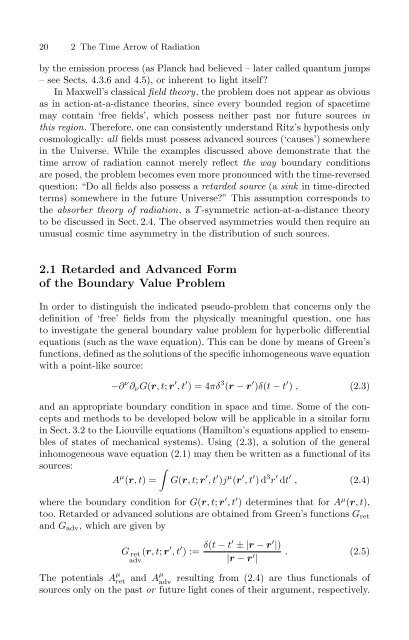The Physical Basis of The Direction of Time (The Frontiers ...
The Physical Basis of The Direction of Time (The Frontiers ...
The Physical Basis of The Direction of Time (The Frontiers ...
You also want an ePaper? Increase the reach of your titles
YUMPU automatically turns print PDFs into web optimized ePapers that Google loves.
20 2 <strong>The</strong> <strong>Time</strong> Arrow <strong>of</strong> Radiation<br />
by the emission process (as Planck had believed – later called quantum jumps<br />
– see Sects. 4.3.6 and 4.5), or inherent to light itself?<br />
In Maxwell’s classical field theory, the problem does not appear as obvious<br />
as in action-at-a-distance theories, since every bounded region <strong>of</strong> spacetime<br />
may contain ‘free fields’, which possess neither past nor future sources in<br />
this region. <strong>The</strong>refore, one can consistently understand Ritz’s hypothesis only<br />
cosmologically: all fields must possess advanced sources (‘causes’) somewhere<br />
in the Universe. While the examples discussed above demonstrate that the<br />
time arrow <strong>of</strong> radiation cannot merely reflect the way boundary conditions<br />
are posed, the problem becomes even more pronounced with the time-reversed<br />
question: “Do all fields also possess a retarded source (a sink in time-directed<br />
terms) somewhere in the future Universe?” This assumption corresponds to<br />
the absorber theory <strong>of</strong> radiation, aT -symmetric action-at-a-distance theory<br />
to be discussed in Sect. 2.4. <strong>The</strong> observed asymmetries would then require an<br />
unusual cosmic time asymmetry in the distribution <strong>of</strong> such sources.<br />
2.1 Retarded and Advanced Form<br />
<strong>of</strong> the Boundary Value Problem<br />
In order to distinguish the indicated pseudo-problem that concerns only the<br />
definition <strong>of</strong> ‘free’ fields from the physically meaningful question, one has<br />
to investigate the general boundary value problem for hyperbolic differential<br />
equations (such as the wave equation). This can be done by means <strong>of</strong> Green’s<br />
functions, defined as the solutions <strong>of</strong> the specific inhomogeneous wave equation<br />
with a point-like source:<br />
−∂ ν ∂ ν G(r,t; r ′ ,t ′ )=4πδ 3 (r − r ′ )δ(t − t ′ ) , (2.3)<br />
and an appropriate boundary condition in space and time. Some <strong>of</strong> the concepts<br />
and methods to be developed below will be applicable in a similar form<br />
in Sect. 3.2 to the Liouville equations (Hamilton’s equations applied to ensembles<br />
<strong>of</strong> states <strong>of</strong> mechanical systems). Using (2.3), a solution <strong>of</strong> the general<br />
inhomogeneous wave equation (2.1) may then be written as a functional <strong>of</strong> its<br />
sources:<br />
∫<br />
A µ (r,t)= G(r,t; r ′ ,t ′ )j µ (r ′ ,t ′ )d 3 r ′ dt ′ , (2.4)<br />
where the boundary condition for G(r,t; r ′ ,t ′ ) determines that for A µ (r,t),<br />
too. Retarded or advanced solutions are obtained from Green’s functions G ret<br />
and G adv ,whicharegivenby<br />
G ret (r,t; r ′ ,t ′ ):= δ(t − t′ ±|r − r ′ |)<br />
adv<br />
|r − r ′ . (2.5)<br />
|<br />
<strong>The</strong> potentials A µ ret and A µ adv<br />
resulting from (2.4) are thus functionals <strong>of</strong><br />
sources only on the past or future light cones <strong>of</strong> their argument, respectively.



![arXiv:1001.0993v1 [hep-ph] 6 Jan 2010](https://img.yumpu.com/51282177/1/190x245/arxiv10010993v1-hep-ph-6-jan-2010.jpg?quality=85)


![arXiv:1008.3907v2 [astro-ph.CO] 1 Nov 2011](https://img.yumpu.com/48909562/1/190x245/arxiv10083907v2-astro-phco-1-nov-2011.jpg?quality=85)








![arXiv:1002.4928v1 [gr-qc] 26 Feb 2010](https://img.yumpu.com/41209516/1/190x245/arxiv10024928v1-gr-qc-26-feb-2010.jpg?quality=85)
![arXiv:1206.2653v1 [astro-ph.CO] 12 Jun 2012](https://img.yumpu.com/39510078/1/190x245/arxiv12062653v1-astro-phco-12-jun-2012.jpg?quality=85)
